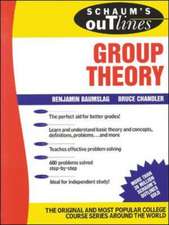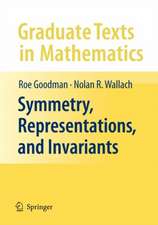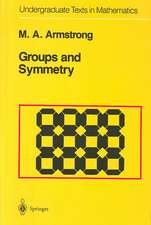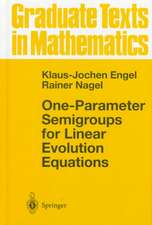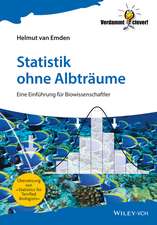Fuchsian Groups: Chicago Lectures in Mathematics
Autor Svetlana Katoken Limba Engleză Paperback – aug 1992
This introductory text provides a thoroughly modern treatment of Fuchsian groups that addresses both the classical material and recent developments in the field. A basic example of lattices in semisimple groups, Fuchsian groups have extensive connections to the theory of a single complex variable, number theory, algebraic and differential geometry, topology, Lie theory, representation theory, and group theory.
Din seria Chicago Lectures in Mathematics
- 8%
 Preț: 463.42 lei
Preț: 463.42 lei -
 Preț: 281.14 lei
Preț: 281.14 lei -
 Preț: 214.68 lei
Preț: 214.68 lei -
 Preț: 227.15 lei
Preț: 227.15 lei -
 Preț: 279.93 lei
Preț: 279.93 lei -
 Preț: 384.89 lei
Preț: 384.89 lei -
 Preț: 374.70 lei
Preț: 374.70 lei - 27%
 Preț: 858.13 lei
Preț: 858.13 lei -
 Preț: 311.17 lei
Preț: 311.17 lei -
 Preț: 290.55 lei
Preț: 290.55 lei -
 Preț: 331.00 lei
Preț: 331.00 lei -
 Preț: 252.55 lei
Preț: 252.55 lei -
 Preț: 259.37 lei
Preț: 259.37 lei -
 Preț: 375.29 lei
Preț: 375.29 lei - 15%
 Preț: 193.91 lei
Preț: 193.91 lei - 20%
 Preț: 159.55 lei
Preț: 159.55 lei - 14%
 Preț: 299.04 lei
Preț: 299.04 lei - 31%
 Preț: 120.47 lei
Preț: 120.47 lei
Preț: 260.52 lei
Nou
Puncte Express: 391
Preț estimativ în valută:
49.86€ • 51.99$ • 41.44£
49.86€ • 51.99$ • 41.44£
Carte tipărită la comandă
Livrare economică 20 martie-03 aprilie
Preluare comenzi: 021 569.72.76
Specificații
ISBN-13: 9780226425832
ISBN-10: 0226425835
Pagini: 186
Ilustrații: 30 line drawings, 1 table
Dimensiuni: 133 x 203 x 15 mm
Greutate: 0.23 kg
Ediția:1
Editura: University of Chicago Press
Colecția University of Chicago Press
Seria Chicago Lectures in Mathematics
ISBN-10: 0226425835
Pagini: 186
Ilustrații: 30 line drawings, 1 table
Dimensiuni: 133 x 203 x 15 mm
Greutate: 0.23 kg
Ediția:1
Editura: University of Chicago Press
Colecția University of Chicago Press
Seria Chicago Lectures in Mathematics
Notă biografică
Svetlana Katok is associate professor of mathematics at Pennsylvania State University.
Cuprins
Preface
1. Hyperbolic geometry
1.1. The hyperbolic metric
1.2. Geodesics
1.3. Isometrics
1.4. Hyperbolic area and the Gauss-Bonnet formula
1.5. Hyperbolic trigonometry
1.6. Comparison between hyperbolic, spherical and Euclidean trigonometry
Exercises for Chapter 1
2. Fuchsian groups
2.1. The group PSL(2,R)
2.2. Discrete and properly discontinuous groups
2.3. Algebraic properties of Fuchsian groups
2.4. Elementary groups
Exercises for Chapter 2
3. Fundamental regions
3.1. Definition of a fundamental region
3.2. The Dirichlet region
3.3. Isometric circles and the Ford fundamental region
3.4. The limit set of [ ]
3.5. Structure of a Dirichlet region
3.6. Connection with Riemann surfaces and homogeneous spaces
Exercises for Chapter 3
4. Geometry of Fuchsian groups
4.1. Geometrically finite Fuchsian groups
4.2. Cocompact Fuchsian groups
4.3. The signature of a Fuchsian group
4.4. Fuchsian groups generated by reflections
4.5. Fuchsian groups of the first kind
4.6. Finitely generated Fuchsian groups
Exercises for Chapter 4
5. Arithmetic Fuchsian groups
5.1. Definitions of arithmetic Fuchsian groups
5.2. Fuchsian groups derived from quaternion algebras
5.3. Criteria for arithmeticity
5.4. Compactness of [ ] for Fuchsian groups derived from division quaternion algebras
5.5. The modular group and its subgroups
5.6. Examples
Exercises for Chapter 5
Hints for Selected Exercises
Bibliography
Index
1. Hyperbolic geometry
1.1. The hyperbolic metric
1.2. Geodesics
1.3. Isometrics
1.4. Hyperbolic area and the Gauss-Bonnet formula
1.5. Hyperbolic trigonometry
1.6. Comparison between hyperbolic, spherical and Euclidean trigonometry
Exercises for Chapter 1
2. Fuchsian groups
2.1. The group PSL(2,R)
2.2. Discrete and properly discontinuous groups
2.3. Algebraic properties of Fuchsian groups
2.4. Elementary groups
Exercises for Chapter 2
3. Fundamental regions
3.1. Definition of a fundamental region
3.2. The Dirichlet region
3.3. Isometric circles and the Ford fundamental region
3.4. The limit set of [ ]
3.5. Structure of a Dirichlet region
3.6. Connection with Riemann surfaces and homogeneous spaces
Exercises for Chapter 3
4. Geometry of Fuchsian groups
4.1. Geometrically finite Fuchsian groups
4.2. Cocompact Fuchsian groups
4.3. The signature of a Fuchsian group
4.4. Fuchsian groups generated by reflections
4.5. Fuchsian groups of the first kind
4.6. Finitely generated Fuchsian groups
Exercises for Chapter 4
5. Arithmetic Fuchsian groups
5.1. Definitions of arithmetic Fuchsian groups
5.2. Fuchsian groups derived from quaternion algebras
5.3. Criteria for arithmeticity
5.4. Compactness of [ ] for Fuchsian groups derived from division quaternion algebras
5.5. The modular group and its subgroups
5.6. Examples
Exercises for Chapter 5
Hints for Selected Exercises
Bibliography
Index

